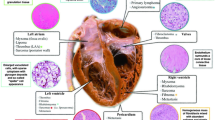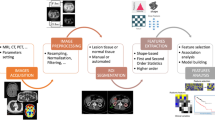Abstract
A large number of studies were presented at the 2014 American Heart Association Scientific Sessions. In this review, we will summarize key studies in nuclear cardiology, computed tomography, echocardiography, and cardiac magnetic resonance imaging. This brief review will be helpful for readers of the Journal who are interested in being updated on the latest research covering these imaging modalities.




Similar content being viewed by others
References
VanDecker W, Bax JJ, Lloyd SG, Einstein AJ, Chaudhry FA, Blankstein R. Multi-modality imaging: Bird’s-eye view from the 63rd Annual Scientific Sessions of the American College of Cardiology. J Nucl Cardiol 2014;21:821-6.
Bax JJ, Delgado V, Achenbach S, Sechtem U, Knuuti J. Multimodality imaging: Bird’s eye view from The European Society of Cardiology Congress 2014 Barcelona, August 30-September 3, 2014. J Nucl Cardiol 2014;21:1245-51.
Johnson SE, Lee DC, Benefield BC, Holly TA, Arora R, Fang W, et al. Global myocardial injury as a new criterion independent of infarct size and area-at-risk. Circulation 2014;130:A20227.
Mc Ardle BA, Shukla T, Bernick J, Davies RA, Duchesne L, Ruddy T, et al. Long term follow-up of outcomes with F-18-Fluorodeoxyglucose positron emission tomography imaging-assisted management of patients with severe left ventricular dysfunction secondary to coronary disease. Circulation 2014;130:A13207.
Skali H, Di Carli MF, Blankstein R, Chow BJ, Beanlands RS, Berman DS, et al. Stress myocardial perfusion positron emission tomography provides incremental risk prediction in subjects with and without diabetes. Circulation 2014;130:A18193.
Kato T, Veeranna V, Shah NR, Taqueti VR, Murthy VL, Foster CR, et al. Prognostic value of coronary flow reserve in patient with prior coronary artery bypass surgery. Circulation 2014;130:A17329.
Russo RJ, Allem J, Costa HS, Silva PD. Reduction in unnecessary radiation exposure for cardiovascular patients by adoption of a stress-first protocol for nuclear-based cardiac stress testing. Circulation 2014;130:A12972.
Mc Ardle BA, Leung E, Ohira H, Cocker MS, deKemp RA, DaSilva J, et al. The role of F(18)-fluorodeoxyglucose positron emission tomography in guiding diagnosis and management in patients with known or suspected cardiac sarcoidosis. J Nucl Cardiol 2013;20:297-306.
Bazylevska V, Feringa HH, Venkata S, Russell RR, Jacoby D, Bellumkonda L. Both semi-quantitative and quantitative assessment of positron emission tomography strongly predicts outcomes in patients being evaluated for cardiac sarcoidosis. Circulation 2014;130:A11771.
Klein T, Abdulghani MS, Asoglu R, Huang R, Smith M, Remo B, et al. Three-dimensional 123I-meta-iodobenzylguanidine (121I mIBG) cardiac innervation maps to guide ablation of ventricular tachycardia-A novel paradigm introducing innervation imaging in ablation therapy. Circulation 2014;130:A17789.
Muhlestein JB, Lappe DL, Lima JA, Rosen BD, May HT, Knight S, et al. Effect of screening for coronary artery disease using CT angiography on mortality and cardiac events in high-risk patients with diabetes: The FACTOR-64 randomized clinical trial. JAMA 2014;312:2234-43.
Young LH, Wackers FJ, Chyun DA, Davey JA, Barrett EJ, Taillefer R, et al. Cardiac outcomes after screening for asymptomatic coronary artery disease in patients with type 2 diabetes: The DIAD study: A randomized controlled trial. JAMA 2009;301:1547-55.
Mahabadi AA, Lehmann N, Mohlenkamp S, Dykun I, Bauer M, Moebus B, et al. Multiple non-coronary CT-parameters improve prediction of hard cardiovascular events above coronary artery calcium scoring and established risk factors: The Heinz Nixdorf Recall Study. Circulation 2014;130:A13145.
Mahabadi AA, Berg MH, Lehmann N, Kalsch H, Bauer M, Kara K, et al. Association of epicardial fat with cardiovascular risk factors and incident myocardial infarction in the general population: The Heinz Nixdorf Recall Study. J Am Coll Cardiol 2013;61:1388-95.
Mahabadi AA, Geisel MH, Lehmann N, Lammerding C, Kalsch H, Bauer M, et al. Association of computed tomography-derived left atrial size with major cardiovascular events in the general population: The Heinz Nixdorf Recall Study. Int J Cardiol 2014;174:318-23.
Kalsch H, Lehmann N, Berg MH, Mahabadi AA, Mergen P, Mohlenkamp S, et al. Coronary artery calcification outperforms thoracic aortic calcification for the prediction of myocardial infarction and all-cause mortality: The Heinz Nixdorf Recall Study. Eur J Prev Cardiol 2014;21:1163-70.
Kalsch H, Lehmann N, Mohlenkamp S, Becker A, Moebus S, Schmermund A, et al. Body-surface adjusted aortic reference diameters for improved identification of patients with thoracic aortic aneurysms: Results from the population-based Heinz Nixdorf Recall Study. Int J Cardiol 2013;163:72-8.
Kalsch H, Lehmann N, Mahabadi AA, Bauer M, Kara K, Huppe P, et al. Beyond Framingham risk factors and coronary calcification: Does aortic valve calcification improve risk prediction? The Heinz Nixdorf recall study. Heart 2014;100:930-7.
Habis M, Ghostine S, Rohnean A, Capderou A, Paul J. Diagnosis of functionally significant coronary stenosis with exercise CT myocardial perfusion imaging. Radiology 2014. doi:10.1148/radiol.14140861.
Thavendiranathan P, Dickerson JA, Scandling D, Balasubramanian V, Pennell ML, Hinton A, et al. Comparison of treadmill exercise stress cardiac MRI to stress echocardiography in healthy volunteers for adequacy of left ventricular endocardial wall visualization: A pilot study. J Magn Reson Imaging 2014;39:1146-52.
Chow BJ, Ananthasubramaniam K, dekemp RA, Dalipaj MM, Beanlands RS, Ruddy TD. Comparison of treadmill exercise versus dipyridamole stress with myocardial perfusion imaging using rubidium-82 positron emission tomography. J Am Coll Cardiol 2005;45:1227-34.
Lozano R, Naghavi M, Foreman K, Lim S, Shibuya K, Aboyans V, et al. Global and regional mortality from 235 causes of death for 20 age groups in 1990 and 2010: A systematic analysis for the Global Burden of Disease Study 2010. Lancet 2012;380:2095-128.
Mathers CD, Loncar D. Projections of global mortality and burden of disease from 2002 to 2030. PLoS Med 2006;3:e442.
Detrano R, Guerci AD, Carr JJ, Bild DE, Burke G, Folsom AR, et al. Coronary calcium as a predictor of coronary events in four racial or ethnic groups. N Engl J Med 2008;358:1336-45.
Blaha MJ, Budoff MJ, DeFilippis AP, Blankstein R, Rivera JJ, Agatston A, et al. Associations between C-reactive protein, coronary artery calcium, and cardiovascular events: Implications for the JUPITER population from MESA, a population-based cohort study. Lancet 2011;378:684-92.
Miller JM, Rochitte CE, Dewey M, Arbab-Zadeh A, Niinuma H, Gottlieb I, et al. Diagnostic performance of coronary angiography by 64-row CT. N Engl J Med 2008;359:2324-36.
Rochitte CE, George RT, Chen MY, Arbab-Zadeh A, Dewey M, Miller JM, et al. Computed tomography angiography and perfusion to assess coronary artery stenosis causing perfusion defects by single photon emission computed tomography: The CORE320 study. Eur Heart J 2014;35:1120-30.
Norgaard BL, Leipsic J, Gaur S, Seneviratne S, Ko BS, Ito H, et al. Diagnostic performance of noninvasive fractional flow reserve derived from coronary computed tomography angiography in suspected coronary artery disease: The NXT trial (Analysis of Coronary Blood Flow Using CT Angiography: Next Steps). J Am Coll Cardiol 2014;63:1145-55.
Arbab-Zadeh A. Fractional flow reserve-guided percutaneous coronary intervention is not a valid concept. Circulation 2014;129:1871-8 (discussion 8).
Tonino PA, De Bruyne B, Pijls NH, Siebert U, Ikeno F, van’ t Veer M, et al. Fractional flow reserve versus angiography for guiding percutaneous coronary intervention. N Engl J Med 2009;360:213-24.
Douglas PS, Hoffmann U, Lee KL, Mark DB, Al-Khalidi HR, Anstrom K, et al. Prospective multicenter imaging study for evaluation of chest pain: Rationale and design of the PROMISE trial. Am Heart J 2014;167:796-803.e1.
Reddy KS. Cardiovascular disease in non-Western countries. N Engl J Med 2004;350:2438-40.
Tsujimoto S, Miyasaka Y, Suwa Y, Maeba H, Yamamoto K, Shiojima I. Prediction of risk for cardiovascular events in patients with preserved left ventricular ejection fraction: Incremental value of diastolic wall motion. Circulation 2014;130:A13816.
Peng T, Zeng N, Migliati ER, Moddy MR, Klegerman ME, Kim H, et al. Xenon delivery into subarachnoid hemorrhage via echogenic liposomes provides long-term neuroprotection. Circulation 2014;130:A15737.
Mousavo N, Tan T, Ali M, Halpern EF, Wang L, Scherrer-Crosbie M. Parameters of left ventricular size and function as predictors of symptomatic heart failure in patients with low normal ejection fraction treated with anthracyclines. Circulation 2014;130:A17994.
Rowin EJ, Maron BJ, Olivotto I, Casey SA, Arretini A, Tomberli B, et al. Stress echocardiography predicts heart failure progression and alters management strategies in patients with hypertrophic cardiomypathy. Circulation 2014;130:A14647.
Chimura M, Onishi T, Kawai H, Yamada S, Yasaka Y. Incremental prognostic value of left ventricular global longitudinal strain and late gadalinium enhancement in patients with dilated cardiomyopathy. Circulation 2014;130:A20072.
Suksaranjit P, Akoum N, Wilson BD, Biskupiak J, Chang L, Velagapudi K, et al. The presence of left ventricular scar in atrial fibrillation is associated with major adverse cardiovascular events. Circulation 2014;130:A17865.
Bhatti S, Watts E, Syed F, Hakeem A. Clinical and prognostic utility of cardiac magnetic resonance imaging in multiple myeloma patients with suspected amyloidosis. Circulation 2014;130:A18297.
Murtagh G, Laffin LL, Beshai JF, Bonham C, Addetia K, Patel AV, et al. Can cardiovascular magnetic resonance identify patients with cardiac sarcoidosis and preserved left ventricular ejection fraction at risk for death and sustained ventricular tachycardia? Circulation 2014;130:A16689.
Venkatesh BA, Yoneyama K, Sharma RK, Ohyama Y, Wu C, Gregory B, et al. Left Ventricular Shape analysis predicts heart failure and coronary heart disease: The Multi-ethnic study of atherosclerosis (MESA). Circulation 2014;130:A14665.
Disclosures
Dr. Einstein reports grant support from GE Healthcare and Phillips Healthcare. Dr. Hage reports grant support from Astellas Pharma USA.
Author information
Authors and Affiliations
Corresponding author
Rights and permissions
About this article
Cite this article
AlJaroudi, W.A., Einstein, A.J., Chaudhry, F.A. et al. Multi-modality imaging: Bird’s-eye view from the 2014 American Heart Association Scientific Sessions. J. Nucl. Cardiol. 22, 364–371 (2015). https://doi.org/10.1007/s12350-015-0076-9
Received:
Accepted:
Published:
Issue Date:
DOI: https://doi.org/10.1007/s12350-015-0076-9




